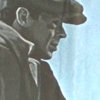
Among the recent gifts to the University of Saskatchewan Archives is a large collection related to prairie popular culture assembled and donated by Brock Silversides. Silversides is a Saskatoon-raised media archivist and popular culture historian whose research and collecting interests include the histories of print advertising, music and photography in the West. One of Silversides’ particular interests is the documentation of motion picture film production on the Canadian prairies, an interest reflected in his collection of one-sheet posters promoting feature films produced in Saskatchewan and Alberta.
 The Silversides collection begins with the National Film Board of Canada’s pioneering feature The Drylanders (1963) which followed the struggles of two generations of settlers in southwestern Saskatchewan. The collection contains posters for most of the recognized classics of prairie cinema including Paperback Hero (1973), a gritty tale of small town despair filmed at Delisle, Saskatchewan and the considerably more upbeat Why Shoot the Teacher? (1976) and Who Has Seen the Wind (1977), based on the novels of Max Braithwaite and W.O. Mitchell.

That many of the films represented in the Silversides collection will be unfamiliar to Canadians demonstrates the difficulty English language Canadian films have traditionally faced in attracting an audience. This lack of success has been attributed to inadequate resources allocated to promotion and to poor domestic distribution opportunities provided by foreign owned distributors and exhibitors.
![Part of East Side Main Street, Morse, Saskatchewan. [19-?].](saskfilm/images/25151-small.jpg)
From the beginning of cinema, making profitable films has demanded a large investment of talent and financial resources in promotion and advertising. Like the live vaudeville shows whose theatres and programs they first shared and whose audiences they soon absorbed, movies have long used eye catching coloured posters as a street level pitch. Initially the images and names of actors were seldom depicted movie posters; prominence was given to the film title and to the names of directors and producers. By the 1920s Hollywood realized that it was the audience’s connection to the featured actors that brought them back to the ticket box.
Although one sheet posters are still produced for most feature films, and the collection of movie posters has become a popular hobby, their role in actually selling tickets has been eclipsed by television and Internet advertising, free distribution movie magazines, theatrical trailers and merchandising tie-ins and promotions.
|






